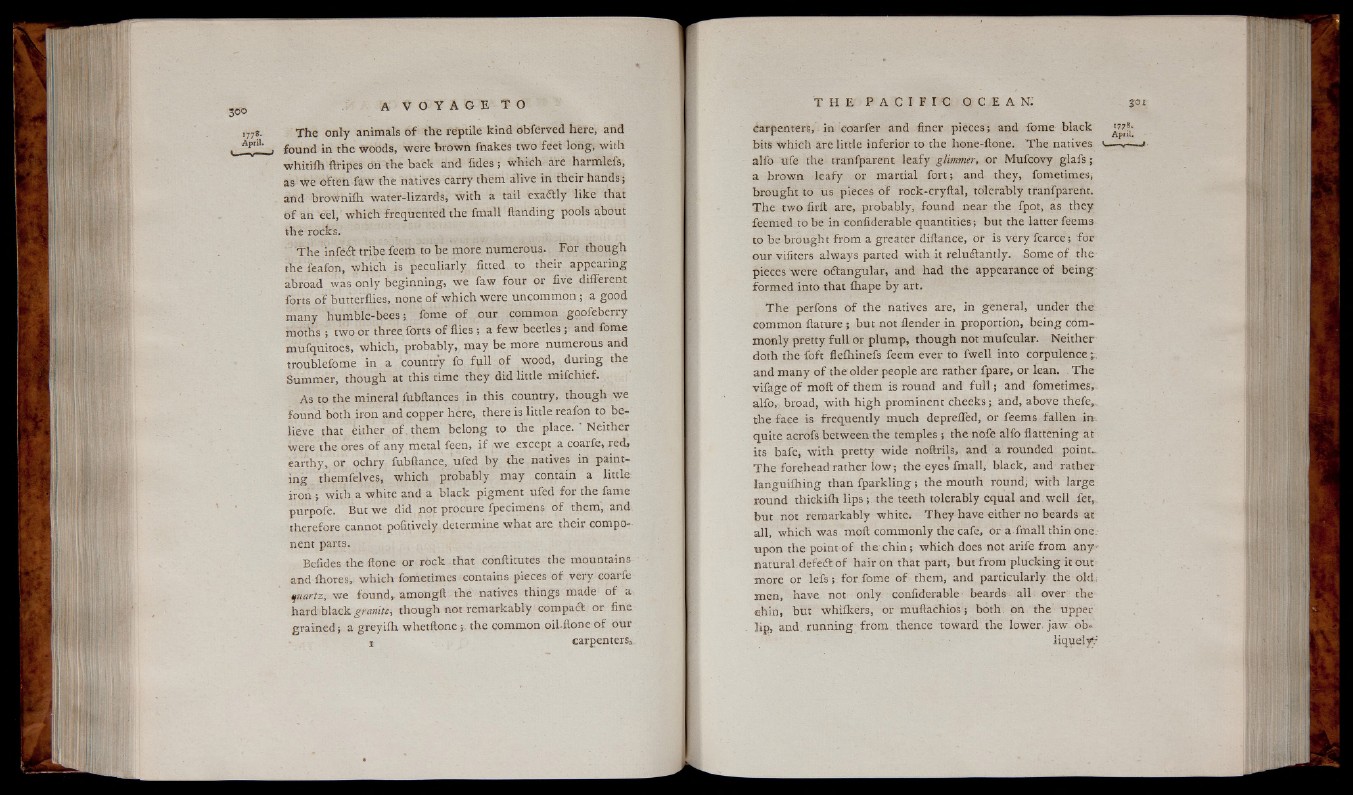
T he only animals o f the reptile kind obferved here, and
found in the woods, were brown fnakes two feet long, with
whitifh ftripes on the back arid fides ; w h ich are harmlefs,
as we often faw the natives carry them alive in their hands;
and brovvnifh water-lizards, w ith a tail e xa ttly lik e that
o f an eel, w h ich frequented the fmall {landing pools about
the rocks.
T h e infeCt tribe feem to be more numerous. For though
the feafon, w h ich is peculiarly fitted to their appealing
abroad was only beginn in g, we faw four or five different
forts o f butterflies, none o f w h ich were uncommon ; a good
many humble-be es; fome o f our common goofeberry
moths ; two or three forts o f flies ; a few beetles ; and fome
mufquitoes, w hich, probably, may be more numerous and
troublefome in a country fo fu ll o f wood, d uring the
Summer, though at this time they did little mifchief.
As to the mineral fubftances in this country, th o u gh we
found both iron and copper here, there is little reafon to believe
that either o f , them be long to the place. Neither
were the ores o f any metal feen, i f w e except a coarfe, red,
earthy, or ochry fubftance, ufed by the natives in paintin
g themfelves, which probably may contain a little:
iron ; with a white and a bla ck pigment ufed for the fame
purpofe. But we did not procure fpecimens o f them, and
therefore cannot pofitively determine what are their component
parts.
Befides the fione or ro ck that conftitutes the mountains
and fliores, w h ich fometimes contains pieces o f very coarfe
quartz, we found, amongit the natives things made o f a.
hard black granite, though not remarkably compadt or fine
grained; a g r e y iih whetftone ; the common oil-ftone o f our
t carpenters»
carpenters, in coarfer and finer pieces; and fome black c u bits
which are little inferior to the hone-flone. The natives 1---- —
alfo ufe the tranfparent lea fy glimmer, or Mufcovy g la f s ;
a brown lea fy or martial fo r t ; and they, fometimes;
brou ght to us pieces o f rock-cryftal, tolerably tranfparent.
T h e two firft are, probably, found near the fpot, as they
feemed to be in confiderable quantities; but the latter feems
to be brought from a greater diflance, or is ve ry fcarce ; for
our vifiters always parted with it reluctantly. Some o f the-
pieces were odtangular, and had the appearance o f b e in g
formed into that fhape by art.
T h e perfons o f the natives are, in general, under the
common llature ; but not {lender in proportion, being commonly
pretty fu l l or plump, though not mufcular. Neither
doth the foft flefhinefs feem ever to fwe ll into corpulence^
and many o f the o lder people are rather fpare, or lean. T h e
vifage o f moil o f them is round and f u l l ; and fometimes,.
alfo, broad, w ith h ig h prominent ch e ek s ; and, above thefe,,
the face is frequently much deprcfled, or feems fa llen in
quite acrofs between the temples ; the nofe alfo flattening at
its bafe, w ith pretty wide noftrils, and a rounded point..
T h e forehead rather low ; the eyes fmall, black, and rather
lan g u iih in g than fp a r k lin g ; the mouth round; with large
round thickiih lips ;. the teeth tolerably equal and. w ell fee,,
but not remarkably white, T h e y have either no beards a t
all, which was moil commonly the cafe, or a fmall thin one.
upon the point o f the c h in ; w h ich does not arife from any-
natural d e fe i to f hair on that part, but from plu ckin g it out
more or le f s ; fo r fome o f them, and particularly the old;
men, have not only confiderable beards all over the
chin, but whiikers, or muftachios; both, on the upper
lip, and running from thence toward the. lower, jaw oblique]
-ft